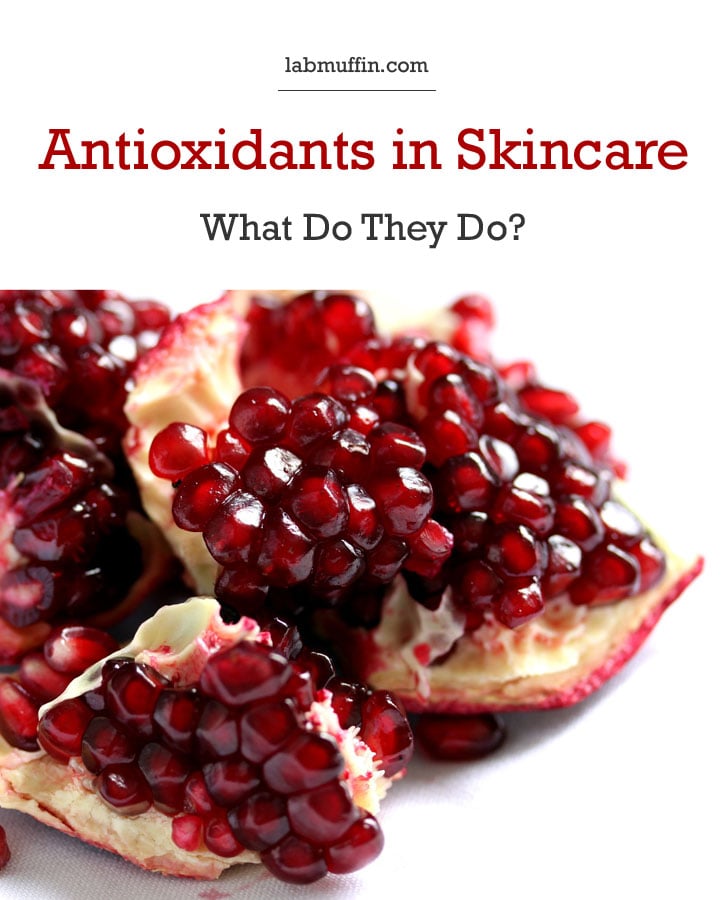
You can find antioxidants in all sorts of products – from food and supplements, to creams and lipstick, and even shampoo. Skincare expert Paula Begoun almost immediately downgrades a product on Beautypedia if it doesn’t contain antioxidants. What are antioxidants doing in your skincare products, how do they work, and what should you look for?
Free Radicals and Skin Damage
One of the key ways in which skin (and your body) ages is through free radical damage, also known as oxidative stress. Free radicals are molecules with an unpaired electron, which make them highly reactive. To become more stable, they have to acquire another electron by taking one from another molecule (aka acting as an oxidant). That molecule now has an unpaired electron, which makes it highly unstable, and it wants an extra electron…see where it’s going? We have a chain reaction. In the process of electron transfer, chemical bonds are broken and new ones form, causing irreversible changes in the molecules’ structure and function.
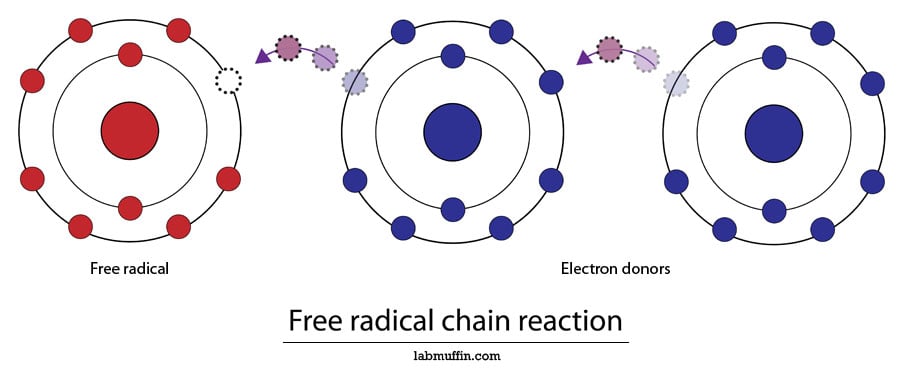
Free radicals are essential in many biological processes, but if too many are formed in the wrong place, they’ll react with whatever’s around – free radicals can attack DNA, proteins and lipids. The electron-stealing chain reactions permanently change the structures of your molecules, leading to the features you’d think of in damaged skin: wrinkles, fine lines, fragile skin, mottled pigmentation and even skin cancers. Free radicals can also trigger inflammation and other harmful pathways in the skin, such as increased production of matrix metalloproteinases (MMPs) which break down collagen in your skin.
Free radicals in living organisms usually contain oxygen, so they’re often called “reactive oxygen species” (ROS for short). The most common free radicals in the body are superoxide O2-• and hydroxyl OH•.
What Causes Free Radicals?
Free radicals are formed during normal biological processes such as respiration. Environmental factors like UV exposure, pollution and cigarette smoke also cause more free radicals in your body, and since your skin is the main interface between you and the outside world, that’s where free radicals form in the greatest amounts.
As I’ve mentioned many times, sun exposure should be one of your biggest skincare concerns, and free radicals are a big part of the reason. Free radicals form in your skin within 15 minutes of exposure to UV, and continues for up to an hour afterwards. Sun damage from UVA exposure is largely from free radical damage, and since UVA penetrates into the dermis, free radical damage can occur quite deeply in the skin. UVB can also produce free radicals too.
How Do Antioxidants Prevent Free Radical Damage?
An antioxidant is any molecule that can neutralise free radicals. They’re usually molecules that are reasonably stable with an unpaired electron, so once the free radical takes their electron, the chain reaction stops. Essentially, they’re like sacrificial shields that intercept the free radicals before they have a chance to react with important biological molecules.
Your body naturally contains antioxidants that soak up free radical damage, including enzymes like superoxide dismutase, catalase and glutathione peroxidase. There are also smaller non-enzymatic antioxidants like vitamins C and E, coenzyme Q10 (ubiquinol) and glutathione. However, these natural mechanisms can become overwhelmed if too many free radicals are present, which is where the idea of topping up your antioxidant stores with antioxidant-containing products come in.
There’s a lot of talk of dietary antioxidants and antioxidant “superfoods” in the media, but it’s still debatable whether taking antioxidant supplements actually helps reduce oxidative stress – clinical studies are divided, likely because antioxidants aren’t getting to the right place or are destroyed during digestion, or may even be reducing oxidative damage in unwanted cells when large supplements are taken. (Luckily, a lot of antioxidant-rich foods are healthy for other reasons, and many of them are cheap, so they’re often worth eating anyway!)
The advantages of applying antioxidant products to your skin are a bit more straightforward, according to the research so far. Since your skin is exposed to the elements (in particular, UV), it’s a part of your body that experiences a lot of extra free radical damage, and can benefit the most from extra antioxidants.
Which Antioxidants Actually Work in Skincare?
Applying more of the antioxidants naturally present in your skin can boost your skin’s ability to neutralise free radicals. The ones you’ll find in skincare products, that have clinical studies to show that they work when applied to skin, include:
- Superoxide dismutase and catalase – Vital antioxidant enzymes in the skin, catalase is also being investigated for preventing grey hair
- Vitamin C – A water soluble vitamin naturally found in skin that protects the inside of the cell. It’s also essential in collagen synthesis and reduces pigmentation. Vitamin C esters don’t have good antioxidant activity, but they still sometimes have the other effects.
- Vitamin E – A fat soluble vitamin that protects cell membranes and is regenerated by vitamin C. Also works well as an emollient moisturiser
- Coenzyme Q10 (Ubiquinone) – An antioxidant that’s also important in energy production. Declines with age, and is a popular supplement for heart health (though whether it’s effective is uncertain)
Other antioxidants that you don’t normally find in large amounts in the body can be used as well. These usually come from plants, since many plants have evolved to deal with high UV exposure, because they’re plants and can’t run away from the sun. Antioxidants in plants are often classified by their chemical structures – you might have heard of polyphenols, flavonoids, isoflavones and anthocyanins before.
Some antioxidants that have been found to reduce the signs of free radical damage in human studies include:
- Ferulic acid – comes from cereal, great at boosting the stability of vitamins C and E
- Green tea polyphenols – most notably epigallocatechin-3-gallate, which is estimated to have 25-100 times as much antioxidant ability as vitamins C and E. Other polyphenols in tea (epicatechin, epicathechin-3-gallate, epigallocatechin) are active antioxidants as well. The greener and fresher the tea, the higher the antioxidant content
- Resveratrol – found in grape skins, peanuts and red wine
- Genistein – an isoflavone from soy
- Lycopene – a red vitamin A compound that comes from tomatoes, watermelons and apricots
- Idebenone – a synthetic compound structurally related to coenzyme Q10
There are also many more antioxidants that haven’t been tested much on humans, but have shown encouraging results on cell lines and animal studies, and are already appearing in skincare products. Some of the more popular ones are silymarin (from milk thistle), coffeeberry, grape seed extract, pomegranate, alpha lipoic acid, curcumin (from turmeric), melatonin and dehydroepiandrosterone (DHEA).
Overall though, the studies aren’t all well designed and are often on small groups, and it’s worth remembering that ingredients that work well in cell lines and animal studies often don’t work on human skin. Some antioxidants also have paradoxical effects – for example, curcumin seems to decrease free radicals at low concentrations but increase them at high concentrations in cell studies.
What Should I Look For in Antioxidant Skincare?

This is a tough question, because a lot has to do with the formulation of the product, not just the antioxidants it contains. First, the antioxidant needs to stay active in the product until you apply it. The antioxidant also has to penetrate the skin, which wants to keep things out, and enough has to penetrate to make a difference – a single antioxidant molecule can’t soak up damage from hundreds of free radicals. Additionally, there are a million variables that can change the potency of a plant extract, such as where the plant’s grown, which variety it is, when it’s harvested, how it’s processed after harvesting, etc.
Annoyingly, there aren’t any reliable methods for measuring the antioxidant protection potential for finished yet, and not many studies have been performed comparing different antioxidant product formulations, so it’s difficult to compare products and know which ones work best.
In the meantime, as we wait for more results, here are a few guidelines as to what to look for in an antioxidant product and how to use them, if you don’t want to wait a decade for convincing evidence:
- The antioxidants with the most evidence supporting them are vitamins C and E, ferulic acid, green tea polyphenols and coenzyme Q10 (ubiquinone). These ingredients will be your best bet for an effective antioxidant product. That’s not to say that other antioxidants don’t work – most of the time, they just haven’t been studied yet.
- Combinations of antioxidants usually perform better, as they can work synergistically to replenish each other. For example, a combination of 15% vitamin C and 1% vitamin E protected against UV damage twice as well as vitamin C alone, and adding ferulic acid helped even more.
- Antioxidants should be applied before free radicals are formed (i.e. before you go into the sun) – if you apply it afterwards, the antioxidants won’t have time to intercept the free radicals before they attack your body. I prefer to use them in the morning for this reason.
My personal approach to dealing with the hazy evidence while preventing wrinkles before they turn up and not going broke is to use antioxidant products that have other, better supported benefits as well – the antioxidants are more of a backup bonus!
Here are some of the antioxidant products I’ve trialled recently:
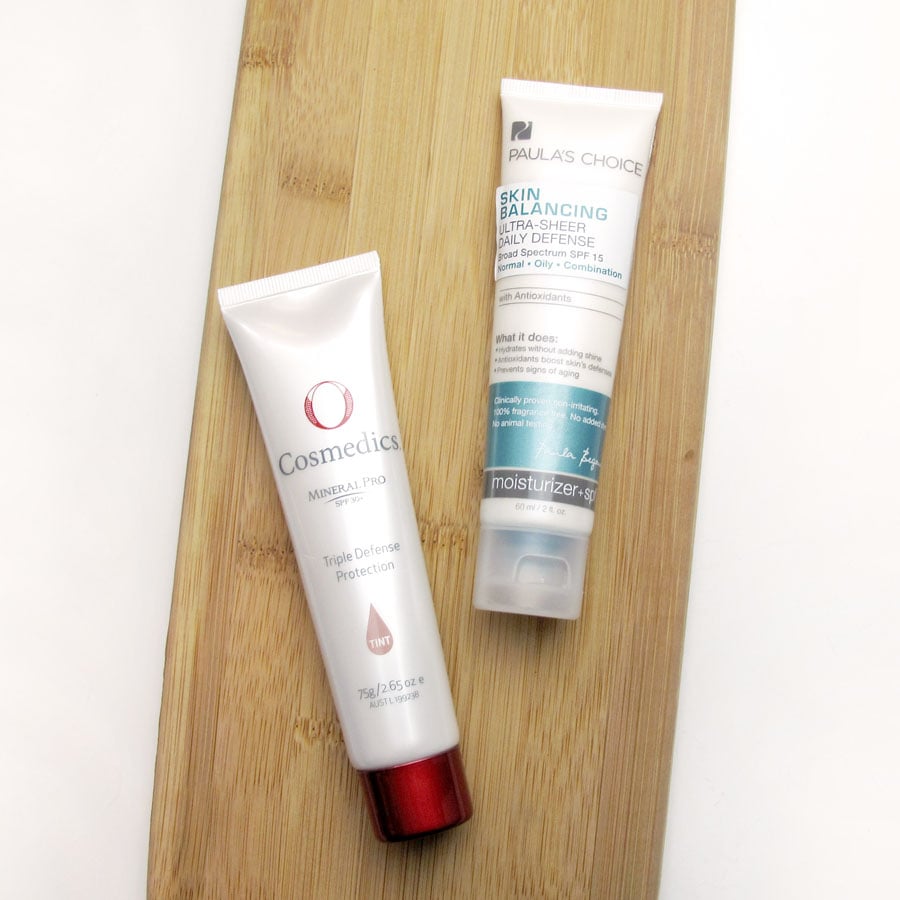
Paula’s Choice Skin Balancing Ultra-Sheer Daily Defense Broad Spectrum SPF 15 ($33 AUD for 60 mL): Paula’s Choice products often contain a combination of antioxidants, which increases the chances that a few will work. This is a light sunscreen that contains green tea extract, superoxide dismutase, vitamin E (tocopherol), boerhavia diffusa and ginkgo biloba as its antioxidants. Unfortunately, the SPF is too low for me to use this as my daily facial sunscreen – the ozone layer in Australia is thin enough that 2 in 3 Australians will be diagnosed with skin cancer by the age of 70, so it’s SPF 30+ or bust for me. I use it as an anti-aging hand cream.
O Cosmedics Mineral Pro Sheer Tint SPF 30+ ($45 AUD for 75 g): This is a physical-only sunscreen containing 20% zinc oxide, with a great formula that doesn’t feel sticky or heavy and has a nice vanilla scent. There isn’t much white cast on my skin thanks to the tint, but it may not work as well on other people. There’s no complete ingredients list, apart from that it contains the antioxidant resveratrol and palmitoyl oligopeptide, which could theoretically boost collagen levels.
La Mav Antioxidant Rich Nightly Repair Nectar ($59.95 AUD for 30 mL): This is an amped-up oil blend, based around rosehip, jojoba and evening primrose oils. It also contains ubiquinone as the key antioxidant ingredient.
The Jojoba Company CoQ10 Antioxidant Serum ($49.95 AUD for 30 mL): A light hydrating serum containing aloe, glycerin, jojoba oil, vitamin C (ascorbyl tetraisopalmitate) and hyaluronic acid, along with antioxidants ubiquinone (coenzyme Q10), tocopherol (vitamin E), alpha lipoic acid, ginseng, green tea, ginkgo biloba, quandong and geranium flower oil. It gives my skin a really nice hydrated bounce, thanks to the humectant-rich base that helps skin hold onto water.
Paula’s Choice Resist Super Antioxidant Concentrate Serum ($52 AUD for 30 mL): A silicone-based product that takes “antioxidants have synergistic effects” to a whole new extreme. Here are the more interesting ones: vitamin E (tocotrienols, tocopherol), coenzyme Q10 (ubiquinone), alpha lipoic acid, ferulic acid, superoxide dismutase, epigallocatechin gallate (from green tea), ergothioneine (from mushroom), glutathione, xanthophyll (a leaf pigment), soybean extract and turmeric root extract. It blends nicely with makeup primer, and it’s reassuring to know that some of them will work, on the balance of probabilities – it’s also got some vitamin C derivatives as well for pigment fading and collagen boosting.
References
L Chen, JY Hu & SQ Wang, The role of antioxidants in photoprotection: a critical review (full text), J Am Acad Dermatol 2012, 67, 1013-1024 (DOI).
SQ Wang, Y Balagula & U Osterwalder, Photoprotection: a review of the current and future technologies (full text), Dermatol Ther 2010, 23, 31-47 (DOI).
JA Nichols & SK Katiyar, Skin photoprotection by natural polyphenols: Anti-inflammatory, anti-oxidant and DNA repair mechanisms (open access), Arch Dermatol Res 2010, 302, 71-83 (DOI).
Do you use antioxidant skincare products? Do you have any favourites?
These products were provided for editorial consideration, which did not affect my opinion. This post also contains affiliate links – if you decide to click through and support Lab Muffin financially (at no extra cost to you), thank you! For more information, see Disclosure Policy.




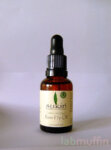
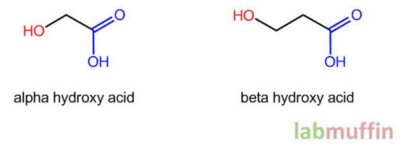
Hi there!
I was wondering if masks containing antioxidants like the Q10 coenzyme are effective, since you rinse it off before being exposed to UVA rays anyways?
Thanks and love your blog!
Thank you! 🙂
Coenzyme Q10 is oil soluble, so if the mask is on for long enough it could penetrate the skin and avoid being washed off, and could stay in the skin for long enough to help with UVA – it might not be quite as effective as applying during the day, but there are other things that cause free radical formation apart from UV, so it’ll help with those.
*Drools over post*
From the healthcare side of things, I can only fill in so much about antioxidants until I run into good ol’ chem (dies inside but only because undergraduate was poo); saying such, this post is lifesaver! I’ve been trying to figure out if truffle oil in the Yuri Pibu products on GlowRecipe is worth trying! Do you have any understanding of how truffle oil is used in this regard?
Thanks for the compliments! 😀
Truffle oil has some antioxidants, although they haven’t been tested on skin as far as I can see. I think it’s more of a fun ingredient than a reliable active unfortunately!
This is slightly off-topic but I hoped you could help explain the difference between enzymes and alpha hydroxy acids in skincare. Lush seem to use the term interchangeably- particularly with the whole ‘lemon juice contains AHA which is an enzyme’, but I vaguely recall from school they’re two different things. Can you help?
Sure! Enzymes are proteins which have a specific function – in skincare they usually chop up proteins on the skin, which helps exfoliation. AHAs are much smaller (often thousands of times smaller) molecules which act on the cell membranes to help exfoliation via breaking a different part of the dead skin. There’s more detail on
Great article as always, Michelle! 🙂
FYI, the Paula’s Choice sunscreen/moisturiser is rated SPF 30 overseas and is still waiting on clearance in Australia with the TGA, so it’s limited to SPF 15 until it’s been rated. They’re the exact same formulation.
Wow! This was so helpful. I talk about antioxidants a lot on my blog but not in depth like this! I will have to link to this post next time I mention them so my readers can really educate themselves on the topic!
Thanks for the great article!
I read that antioxidants won’t stay active in products that contain water. Would you agree?
The Paulas Choice Serum you mention is too heavy for me and breaks me out. So I wonder if the light version, which contais water, or one of the Paulas Choice Toners would be an option.
Ugh, you explain things so well. I’d been hoping you’d dissect anti-oxidants for us and you answered my prayer! However much I’ve read around a topic, I always understand things better after you’ve explained it, thank you.
Thanks so much for this! What about DIY antioxidant serums using powdered L-Ascorbic Acid for the vitamin C component? Are they effective if at the right concentration and ph? Could you add oil such as Argan for vitamin E? I’ve seen tons of recipes and usually make this myself, but am not sure if I’m doing more harm than good…
DIY vitamin C works great – I have a post planned about this actually! You could add an oil but oil and water don’t mix well unless you’re using an emulsifier, so if you’re not then I’d recommend layering them on top of each other when you apply them instead of premixing them.
what benefits do you think pomegranate powder would have, say if it were mixed into a face/clay mask?
It’s hard to say – I don’t think there’s much data on the penetration speed of pomegranate antioxidants! In general, leaving it on the skin for longer is better, so creams and serums are usually more effective than a mask that gets washed off.
Hi Michelle!
I am thoroughly enjoying all of your posts. What I would like to know is about the permeability of various products into the skin. Is it possible for the skin to ‘drink’ a moisturizer such as oils or creams, when the skin is particularly dry, for whatever reason? And at another point in time, not seem to absorb it all? If I put rosehip seed oil on my face and apply a serum or active on top of that, does it all get absorbed? I keep reading that the skin is most permeable when wet- how would this effect using serums on wet skin? Is permeability always dependent on molecule size?
I remember a pharmacist, years ago, telling me about emu oil as an amazing ‘carrier’. What would this mean when applied to skincare?
And does comedigenic properties of oils have any bearing on being skin- permeable?
I’m sure this could be a long blog- fine with me! I would LOVE to know the answers to these queries.
Hi Michelle,
Thank you for sharing this blog, I had so much to learn. I only use natural products because I know they are good but not knowing the root causes, benefits and so on. I will come to stop by again next time.
Coincidentally I just made a video on whether natural beauty products are better or safer for you, it’s here: https://www.youtube.com/watch?v=wCO0k-COsZY
Hey Michelle,
Thank you for sharing things about antioxidants. This is a lot of help when choosing the best skincare products. As usual, I prefer to use products with CoQ10 because everything with this antioxidants is effective to my skin.
Thanks so much for this informative post! Would antioxidants need to be reapplied in order to be effective, just as with SPF?
It would be good, but it depends how much you apply in the first place!
I tried a facial at a spa in Florida, they used products that have resveratrol in them and my skin is glowing afterwards. It’s been two weeks since my facial and I could say it was really effective, my skin has never looked better.
I’d love to try that product with resveratrol since I want to incorporate resveratrol into my regimen.
Do you think a DIY serum of some kind with green tea has a chance of being effective, the way your vitamin C serum is? If so, how would one make it?
Pure L-ascorbic acid from a trustworthy source is harder to come by on a budget where I live, but green tea is available in every supermarket.
It should be effective! Just make green tea fresh and apply it, or you can try to make one using a preservative as well.
Thanks for replying. It occurred to me later that this might need to be a strong green tea, and a tea that dark is likely to at least stain clothes, if not skin. I was thinking of this for whole body application, so I might try it with crummy old clothes first, or try it just on the face.
If you consider reader ideas for possible post topics, a round up of the possibilities of makinfgone’s one antioxidant serums/ toners would be great! I’m very far from being a DIY enthusiast, but I simply can’t find pocket-friendly body products with antioxidants where I live; at least none without unsavoury “fairness” and “whitening” labels.
hey michelle, i was wondering how you’d incorporate both a Skinceuticals vitamin c serum and NIOD’s superoxide dismutase saccharide mist into a daytime skincare routine. which one goes on first?
I have a question about ‘extracts’ — I just bought a moisturizer that has green tea EXTRACT in it… what does this mean exactly? My gut based off of reading this article says it’s more of a ‘fun’ ingredient than an actual active (like you’d want to have an actual green tea polypheol in the ingredients to trust that it is doing something) but is there a chance an ‘extract’ can actually do something?
Thanks! Love the blog! <3
I want to add on to the comments about green tea. Same here, green tea is quite easily available around where I live. Should we adjust the ph of the green tea DIY too? I mean does it get ineffective after a certain ph? And if we don’t adjust it’s ph, does the pH it have my default even safe/good for the skin? Thanks in advance, your blog is super informative.
Thanks for providing some insight on antioxidants! I was wondering if there’s any data on the topical use of Pycnogenol, and if that would be a good antioxidant to use?